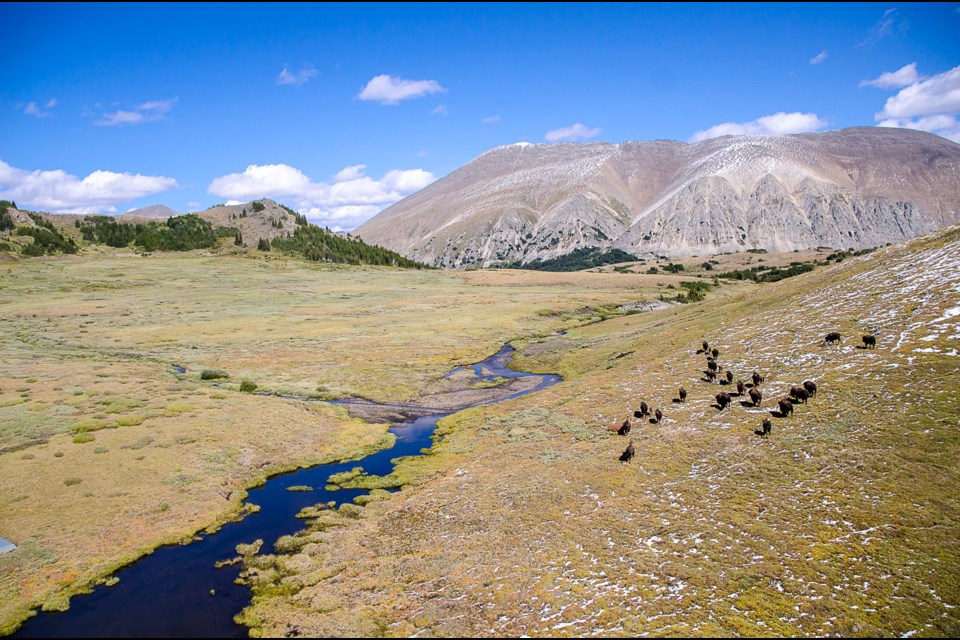PANTHER VALLEY – After being absent from the landscape for over a century, plains bison now roam free once again in Banff National Park.
In late July of 2018, Parks Canada released 31 bison from an enclosed pasture in Panther Valley, where they had been getting acquainted with their new home on the eastern slopes of the Canadian Rockies.
“We think it’s going really well so far,” said Karsten Heuer, bison reintroduction project manager with Parks Canada. “The animals have really adjusted to the mountainous landscape well. They are using the high elevations in summers and the low valley bottom meadows in fall, winter and early spring.”
The individuals in the group are also looking healthy according to Heuer, and an indicator reflective of that good health is the herd as a whole is reproducing at an encouraging rate. As many as 20 calves are expected next spring.
“This last year we had 16 born,” Heuer said, “and that was of a possible 17 sexually mature females. So, that’s a pretty incredible birth rate.”
One of the 16 new calves did not survive. It was killed by wolves within a day or two of birth, but the herd count now stands at 50 individuals and growing.
There were a lot of unknowns coming into such an ambitious project. It’s not every day that you reintroduce North America’s largest land mammal back onto the landscape.
To the casual observer, a plains bison is an animal designed for wide open spaces. Even the project team did not know exactly what to expect, but the animals have adapted to their new neighbourhood without missing a beat.
“I think we were all surprised with how quickly they started using the rugged and high elevation habitat that’s available to them,” Heuer said. “Especially because these are animals that came from Elk Island, which is pretty much flat.
“It doesn’t even have moving water in it, and these guys went up into the alpine and even onto ridge crests in their first week when we released them. And we thought that was maybe a little bit of an outlier, but it’s actually been a pattern that they’ve adopted for all three of the summers that they’ve been free.”
This wandering instinct has exposed some natural history in the area that had been largely concealed by the remoteness of the terrain and the extended absence of large herbivores.
“We, and they, have actually discovered archeological evidence of their ancestors up in those high areas,” Heuer said. “They’ve actually uncovered some of their ancestor’s own bones in their new trails and wallows that they’ve been creating. So, they’re reactivating the very landscape that their ancestors used.”
As a keystone species – an animal that helps hold an ecosystem together – the bison are finding their natural place in the order of things in other ways as well.
“There are very few wild and free plains bison populations left in the world, and one thing that’s really quite special about this one, is they continue to be under the influence of natural selection,” Heuer said.
“And I mean all influences of natural selection. Climate. Weather systems rolling through. Droughts. Floods. And maybe most importantly, natural predators preying on them. Part of the reason bison are the incredible animals that they are today is because of that shaping pressure.”
In addition to reclaiming their historic range and returning to their place on the food chain, this new herd in Banff National Park are also doing a good job in reinvigorating the landscape they’ve been released onto, further reinforcing their importance to the ecosystem.
“It’s early stages,” Heuer said, “and there’s not that many bison on the landscape yet, but even at these low numbers we’re seeing some pretty nice changes [due] to the influence they’re having.
"In some of their favourite meadow systems the grass is noticeably more lush because of the grazing pressure and the nutrient recycling that they are doing.”
Framed as a five-year pilot project, the bison restoration trial is due for assessment in 2022. At that time the accumulated research and monitoring will be shared with stakeholders and the question will be asked, is this a feasible thing to do longer term?
“So far, it’s firmly pointed toward ‘it’s been a good idea,’ ” Heuer said, before adding,
“It’s been a tremendous privilege for all of us at Parks Canada to work on this on behalf of all Canadians, to bring North America’s largest land mammal back to Canada’s first national park.”
To follow developments with the Banff bison herd, go to the Parks Canada website at pc.gc.ca and follow the links to the plains bison reintroduction blog.
Read more from RMOToday.com



